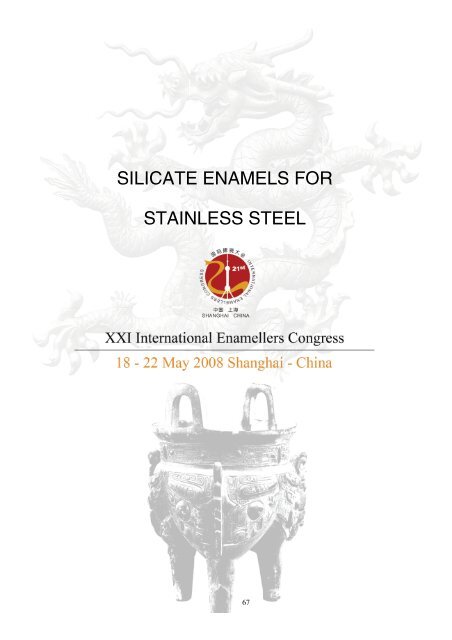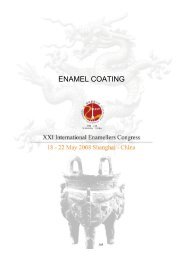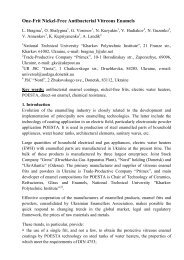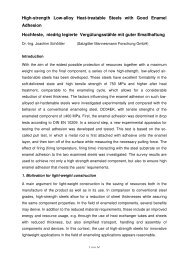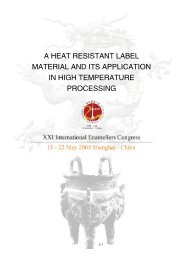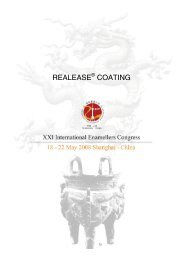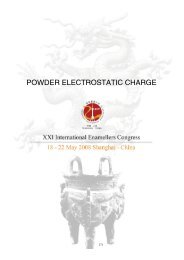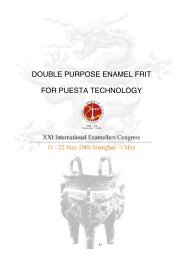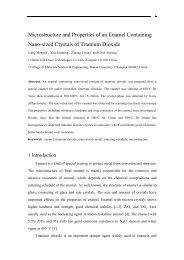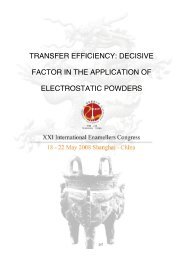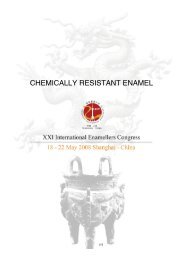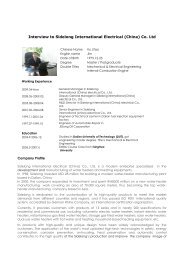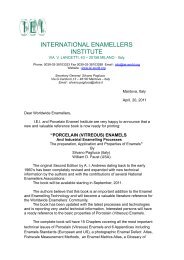Silicate Enamels for Stainless Steel - IEI, International Enamellers ...
Silicate Enamels for Stainless Steel - IEI, International Enamellers ...
Silicate Enamels for Stainless Steel - IEI, International Enamellers ...
You also want an ePaper? Increase the reach of your titles
YUMPU automatically turns print PDFs into web optimized ePapers that Google loves.
SILICATE ENAMELS FORSTAINLESS STEEL67
XXI <strong>International</strong> <strong>Enamellers</strong> Congress<strong>Silicate</strong> <strong>Enamels</strong> <strong>for</strong> <strong>Stainless</strong> <strong>Steel</strong>Bianca Heid, Günther Heinz Frischat, Peter HellmoldInstitute of Non-Metallic Materials, Research group <strong>for</strong> Glass and Glass Technology ClausthalUniversity of TechnologyZehntnerstraße 2a, D – 38678 Clausthal-Zellerfeld, GermanyAbstract For the development of enamels with different properties an experimental design was used inwhich the composition of different raw materials was varied. The enamels were applied on three stainlesssteel grades with a spray gun and fired at 820°C. Different pre-treatment methods (degreasing, picklingand blasting) <strong>for</strong> stainless steel sheets were used to find the method which leads to the best enameladhesion on stainless steel. Blasting with corundum results in sufficient adhesion <strong>for</strong> all enamelled sheets.The analysis of statistical design shows the influence of the enamel raw materials on the differentproperties measured (e. g. chemical stability, coefficient of thermal expansion). The reasons <strong>for</strong> the limitsof applicability of differently composed enamels on stainless steel substrates with defined coefficients ofthermal expansion are discussed. Furthermore, colouring possibilities of direct-on enamels <strong>for</strong> stainlesssteel are mentioned.Key words enamelling, stainless steel, corrosion protection, substrate pre-treatment, statistical designand analysis of experimentsIntroductionEnamelling of stainless steel seems to be an unnecessary rise in cost of an already expensiveproduct. In many cases stainless steel is used because of its higher application temperature and itshigher chemical stability. However, extreme conditions (e. g. contact with acid condensates or gasesunder oxidising conditions at high temperatures) can cause a measurable corrosion of the stainlesssteel.<strong>Enamels</strong> provide an additional corrosion protection and increase the product lifetime of theequipment <strong>for</strong> the chemical industry. Another advantage is protection of the environment againsttoxic components released from the alloy (e. g. Ni or Cr). This is of special importance <strong>for</strong>pharmaceutical, food and housewares industries.Furthermore, an enamelled stainless steel surface may avoid uncontrolled catalytic effects whichcan take place in chemical syntheses by contact of the alloying elements (Ni, Mo, W) with the reactionmixture. Other advantages are a better hygienic behaviour concerning the adhesion of spores andsufficient cleaning possibilities and the opportunity of design in terms of colour, e. g. <strong>for</strong> tubes.However, chrome-nickel steel is difficultly to be enamelled because of its high coefficient of thermalexpansion (CTE). This fact can cause high stress in the enamel coat so that the enamel can chip off.Microstructural changes during heating can cause poor adherence of the enamel on chrome steel.The main research objective of this work was the systematic development of single-layer enamels<strong>for</strong> stainless steel substrates with CTEs of 122 … 193 · 10 -7 K -1 , with chemical and optical propertiescomparable to standard quality enamels.68
<strong>Silicate</strong> <strong>Enamels</strong> <strong>for</strong> <strong>Stainless</strong> <strong>Steel</strong>A secondary objective was to examine the colouring possibilities of such enamels, based onprevious results [3].To adapt enamels on stainless steel substrates, different ways of solution were possible. Thefollowing factors had to be varied:- metal substrate- metal pre-treatment- enamel composition (chemical components and phases)- baking conditions (temperature, time)- coating (one-coat or two-coat enamel).A variation of the metal substrate could only be realised by a selection of different commercial typesof stainless steels, while a stepwise changing of composition of the stainless steels was not possiblein this project. Different methods of pre-treatment have been tested. The sheets were pre-treated bydegreasing, pickling or blasting. Baking conditions were at 820 °C <strong>for</strong> 4.5 min and an one-coatenamel was used. The chemical composition of the enamel was varied by a statistical design ofexperiments.Statistical design of experimentsThe method of statistical design of experiments is used to reduce the number of experiments and tostill get more in<strong>for</strong>mation per test series [6], [7].Classical test series only change one parameter per experiment (One-factor-at-a-time). Therebymany individual tests are needed to cover all test alternatives and to interpret certain differences inthe results. In contrast to this, by using the method of statistical design of experiments, severalparameters can be changed at the same time. There<strong>for</strong>e, less individual tests are needed and moredata can be obtained <strong>for</strong> every test result (Fig. 1).Fig. 1 Difference between classical and statistical design of experimentsWith the aid of suitable software, a mathematical correlation can be established between parametersand target factors, thus objective statements about the influence of these parameters can be made.Furthermore, optimised enamel compositions can be calculated if the composition is within the areaof investigation. Extrapolations beyond are not allowed.Varied factors <strong>for</strong> experimental design were the raw materials quartz, soda, borax, barium carbonateand lithium carbonate. Constant factors were calcium carbonate, manganese oxide and cobalt oxide(Table 1). The target factors investigated were the coefficient of thermal expansion, softening point,glass transition temperature, chemical stability and visual appearance of the enamel surface andgloss.69
XXI <strong>International</strong> <strong>Enamellers</strong> CongressTable 1 Fraction of the factors <strong>for</strong> experimental designRaw materials %Quartz 45 to 60Soda 10 to 35Borax 10 to 25Li 2CO 3 0 to 5BaCO 3 0 to 2CaCO 3, MnO 2, CoO constant at 8The composition of the frit, which represents the basis of the statistical design of experiments, islisted in Table 2.Table 2 Composition of the basic frit according to HILLER [1]Oxide %SiO 2 57Na 2O 22B 2O 3 14CaO, MnO, CoO 7Samples and sample preparationThree different grades of stainless steels were used (Table 3).Table 3 Coefficients of thermal expansion of the stainless steels usedSample number E1 E2 E3Grades Ferritic Duplex AusteniticCTE 20-375°C [10 -7 K -1 ] 122 151 193The stainless steel E1 was ferritic steel with a low CTE, E2 was Duplex steel with a higher CTE, andE3 was austenitic steel with a very high CTE.For sample preparation, different steps were necessary. First, the raw materials had to be weighedand mixed <strong>for</strong> producing enamel frits. This mixture had to be melted in a fireclay crucible at 1300°Cand quenched then in cold water. The stainless steel plates <strong>for</strong> the experimental design were pretreatedby blasting them with corundum. The enamel slurry was made by grinding the frits with waterand mill additions, and then it was applied with a spray gun on the stainless steel sheets. Theseenamelled sheets were dried and fired then at 820 °C <strong>for</strong> 4 min.ResultsInfluence of pre-treatment of stainless steelThe following different pre-treatment possibilities were tested to elucidate their influence on theadhesion of enamels on stainless steel (q. v. [2]):- degreasing- pickling with hydrochloric acid- blasting with corundum.Fig. 2 shows the effect of the pre-treatment methods on the enamel adherence on stainless steel.70
<strong>Silicate</strong> <strong>Enamels</strong> <strong>for</strong> <strong>Stainless</strong> <strong>Steel</strong>E1 E2 E3 E1 E2 E3a) c)b) d)Fig. 2 Comparison of enamelled sheets after different pre-treatment methodsa) degreased; no adhesive oxide in the enamel; b) degreased; with 1 g CuO / 100 g fritc) pickled in hydrochloric acid; with 1 g CuO / 100 g frit; d) blasted with corundum; with 1 g CuO / 100 g fritThe experiments of the different pre-treatment possibilities <strong>for</strong> stainless steel sheets show thatcorundum blasting of the sheets achieves the best adhesion of enamel on stainless steel. Theenamel adheres well on all three types of stainless steel. After degreasing and no additionaladhesive oxide in the frit, the enamel only adheres on chrome steel, which has a low coefficient ofthermal expansion. The two other types (Duplex steel with middle CTE and chrome-nickel steel withhigh CTE) show no adhesion with the enamel; it chips off immediately after firing. The addition of 1 gCuO / 100 g frit leads to an enamel adhesion on the stainless steels E1 and E2. Pickling of stainlesssteel sheets does not improve the enamel adhesion.Fig. 3 displays the differences in surface quality of stainless steel grades used after degreasing andafter pickling. The influence of pickling is obvious only on stainless steel 1. The surfaces of stainlesssteels 2 and 3 show no differences between the two pre-treatment methods. This is due to a highercontent of alloying additions of the chrome-nickel steel which leads to a higher corrosion resistanceof this steel.(a)<strong>Stainless</strong> steel 1 <strong>Stainless</strong> steel 2 <strong>Stainless</strong> steel 3(b)Fig. 3 Microscopic images of surfaces of the stainless steels, 100 x magnified(a) degreased; (b) pickledInfluence of blasting process on the surface quality of the enamelProblems with changing of the quality of the enamel surface led to new conclusions about theoptimised blasting process. The enamel surface of some samples showed many pin holes. Other71
XXI <strong>International</strong> <strong>Enamellers</strong> Congresssamples did not show these defects, although the stainless steel substrates, the enamel and thefiring conditions were the same. The different appearances of the enamel surfaces could only beexplained by the fact that the substrates were blasted on different days by different persons. It issupposed that the main cause <strong>for</strong> pin holes on the enamel surface is a too long blasting process anda too rough stainless steel surface. To corroborate this assumption, test series were per<strong>for</strong>med withdifferent times of blasting. The enamel surface of long blasted sheets showed pin holes, the surfaceof short blasted sheets did not. The different roughnesses of the sheets were verified by ameasurement with a profilometer. The too long blasting time caused an inclusion of bubbles duringthe blasting process. These bubbles could leave the molten enamel layer too late and led to pinholes on the enamel surface.Formation of a wavy enamel surfaceA <strong>for</strong>mation of a wavy enamel surface was observed during the heat-up phase only on chromenickelsteel while firing the enamel. This effect was mainly noticed <strong>for</strong> enamels with more than 60 %SiO 2 . Increasing SiO 2 content means lower CTE and higher viscosity [4], [5]. The <strong>for</strong>mation of awavy enamel surface is caused by a very high CTE of the chrome-nickel steel and by tearing openof the enamel biscuit layer during firing (see Fig. 4). Increasing the time of firing does not allow themolten enamel layer to be smoothened because of its high viscosity.200 – 500°C600 – 675°Cfirst hairline cracks725°C; enamel biscuitlayer tears open775 °C; <strong>for</strong>mation of awavy enamel surface805°C; molten enamellayer does not get smooth835°C; molten enamellayer does not get smoothFig. 4 Formation of a wavy enamel surface with increasing temperatureComputer-based evaluation of the influences of raw materials on desired propertiesThe enamels developed show very different property data (see Table 4). Thus the CTE, <strong>for</strong> example,varies from 99 to 146 ⋅ 10 -7 K -1 , so that it is possible to find an appropriate enamel <strong>for</strong> any stainlesssteel grade.72
<strong>Silicate</strong> <strong>Enamels</strong> <strong>for</strong> <strong>Stainless</strong> <strong>Steel</strong>Table 4 Summary of property data of the enamels developedPropertyDataChemical resistance0.1 – 6.3 g/m²⋅dRelative flow length 0.6 – 1.5Coefficient of thermal expansion 99 – 146 ⋅ 10 -7 K -1Glass transition temperature T g 431 – 498°CSoftening point T SP 477 – 554°CThe analysis of statistical design shows the influence of the individual enamel raw materials on thedifferent properties measured (e. g. chemical stability, CTE). Its impact may be seen from coefficientplots, as illustrated in Fig. 5. The bars specify direction and size of the effect and the 95 %probability confidence interval indicates the coefficient value being in this interval.Coefficients <strong>for</strong>Chemical resistance against water vapourCoefficient of thermal expansionQuartzSodaBoraxLi2CO3BaCO3InteractionSoda x Li2CO3QuartzSodaBoraxLi2CO3BaCO3InteractionSoda x Li2CO3Δ weight loss in g/m²⋅dΔ CTE in 10 -7 K -1Fig. 5 Coefficient plot <strong>for</strong> enamel properties „Chemical resistance against water vapour” and „CTE”The statistical analysis of the results displays the following influences when increasing the content ofthe raw materials:- Quartz reduces the weight loss by chemical corrosion, relative flow length and CTE, andincreases T g and T SP- Soda increases the weight loss, relative flow length and CTE, and reduces T g and T SP- Borax increases the relative flow length and CTE- Li 2 CO 3 increases the relative flow length and CTE, and reduces T g .Colouring possibilitiesWhen developing coloured enamels <strong>for</strong> stainless steels, one first has to remove all colour oxidesoriginally present in the mixture. Colour pigments were added then with two different contents (2 %and 5 %) to the mill batch. The colour pigments used are described in [3]. The colour intensities andshades obtained are illustrated in Fig. 6.73
XXI <strong>International</strong> <strong>Enamellers</strong> CongressE1 E2 E3 E1 E2 E3 E1 E2 E32%5%(a) (b) (c)Fig. 6 Colour intensities and shades of enamels on different stainless steel substrates:(a) with chromium-rutile-colour pigment; (b) with zircon-iron-pink-colour pigment; (c) with cobalt-spinel-colour pigmentAs displayed in Fig. 6, different colour pigments developed a different covering power. Increasing thecontent of colour pigments intensified the colour and varied the shade. The surface quality of theenamels was dependent on the stainless steel grade used. Coloured enamels applied on stainlesssteel 1 always showed a much blistered surface. Most trials showed a more or less blistered enamelsurface with pin holes. Because of a late degassing, bubbles could not leave soon enough themolten enamel layer.SummaryThe results of the investigation show that a corundum blasting of stainless steel sheets results insufficient adherence against impact load <strong>for</strong> all enamelled sheets. A sufficient enamelling at theedges was found <strong>for</strong> most of the enamelled sheets. The best results were achieved with a rawmaterial composition of ≈ 45 % quartz, 20 % soda and 25 % borax (<strong>for</strong> 820 °C as a firingtemperature).The three stainless steels used have different preconditions <strong>for</strong> a successful enamelling. For thechrome steel, the CTE of the enamel frit has to be < 130 ⋅ 10 -7 K -1 , otherwise tensile stressesdevelop. Chrome-nickel-molybdenum steel is easy to enamel, shows a smooth enamel surface inmost experiments and there are no problems with an aligned CTE of the enamel frit. When usingchrome-nickel steel as a substrate <strong>for</strong> enamelling, compressive stress can develop if the CTE of theenamel frit is too low.AcknowledgementsThis work was financed by the program of the AiF (Arbeitsgemeinschaft industriellerForschungsvereinigungen) <strong>for</strong> the advancement of the "Industrielle Gemeinschafts<strong>for</strong>schung (IGF)"utilizing resources provided by the "Bundesministerium für Wirtschaft und Technologie", Germany.Literature[1] L. Hiller: Haftung von Emails auf Sondermetallen und Legierungen. Dissertation, Martin-Luther-Universität Halle-Wittenberg 1995[2] A. Schröder: Untersuchungen zur Haftung von chemisch beständigen Einschichtemails auf Cr-Ni-Stahl.Dissertation, Martin-Luther-Universität Halle-Wittenberg 1998[3] P. Hellmold, B. Rödicker and H. A. Maauof: Farbwirkungen von Buntpigmenten in Emails. Mitt. DEV 51 (2003) 2-8[4] A. H. Dietzel: Emaillierung: Wissenschaftliche Grundlagen und Grundzüge der Technologie. Springer-Verlag,Berlin Heidelberg New York 1981[5] A. Petzold, H. Pöschmann: Email und Emailliertechnik. 2. Aufl. Dt. Verl. für Grundstoffindustrie, Leipzig Stuttgart 1992[6] H. Petersen: Grundlagen der statistischen Versuchsplanung. Band II. ecomed verlagsgesellschaft,Landsberg/Lech 1991[7] E. Scheffler: Statistische Versuchsplanung und -auswertung : Eine Einführung für Praktiker. 3. Aufl. Dt. Verl. fürGrundstoffindustrie, Stuttgart 199774


